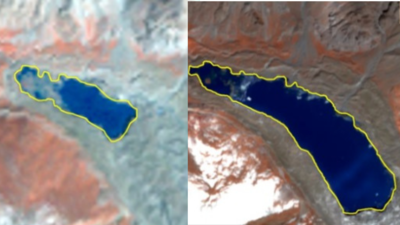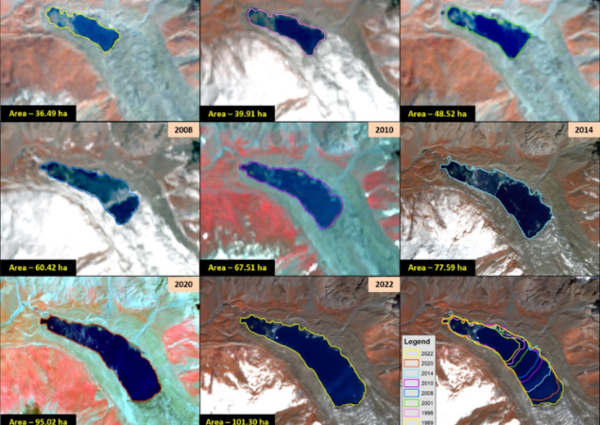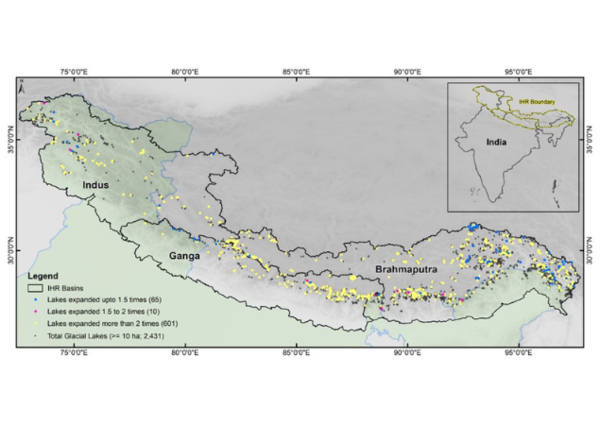- News
- India News
- Glaciers melting at unprecedented rates in Indian Himalayan region: Isro
Trending
Glaciers melting at unprecedented rates in Indian Himalayan region: Isro

BENGALURU: The Himalayan mountains, often called the “Third Pole” due to their vast glaciers and snow cover, are highly vulnerable to global climate change impacts both physically and societally. Isro Monday said that new research analysing decades of satellite imagery has revealed that glaciers across the Indian Himalayan region have been melting at alarming rates, leading to the significant expansion of glacial lakes.
Research conducted worldwide has consistently shown that glaciers across the globe have been experiencing unprecedented rates of retreat and thinning since the onset of the industrial revolution in the 18th century.
“...This retreat leads to the formation of new lakes and the enlargement of existing ones in the Himalayan region. These bodies of water, created by the melting of glaciers, are known as glacial lakes and play a crucial role as freshwater sources for rivers in the Himalayan region. However, they also pose significant risks, such as Glacial Lake Outburst Floods (GLOFs), which can have devastating consequences for communities downstream,” Isro said in a statement on Monday.
For the research, Isro used satellite data from 1984 to 2023, which shows that of the 2,431 glacial lakes larger than 10 hectares identified in 2016-17 across river basins, a staggering 676 lakes have grown markedly since 1984. This includes 130 lakes within India — 65 in the Indus basin, seven in the Ganga basin, and 58 in the Brahmaputra basin.
 The long-term changes in the Ghepang Ghat Glacial Lake area (Credit: Isro)
The long-term changes in the Ghepang Ghat Glacial Lake area (Credit: Isro)
The changes have been drastic, with 601 of the expanding lakes more than doubling in size. Ten lakes grew 1.5 to 2 times larger, while 65 expanded 1.5 times. The analysis found many of the bulging lakes at higher elevations, with 314 between 4,000-5,000 metres and 296 above 5,000 metres.

The glacial lakes are categorised based on their formation process into four broad categories, namely Moraine-dammed (water dammed by moraine), Ice-dammed (water dammed by ice), Erosion (water dammed in depressions formed by erosion), and other glacial lakes.
“Among the 676 expanding lakes, the majority of them are Moraine-dammed (307) followed by Erosion (265), other (96), and Ice-dammed (8) glacial lakes, respectively,” Isro said.
One example is Ghepang Ghat lake in Himachal Pradesh, which has grown 178% larger from 36.49 to 101.3 hectares between 1989-2022 at a rate of nearly 2 hectares per year.
As glaciers rapidly melt, the swelling lakes not only indicate monumental environmental changes but also elevate risks of glacial lake outburst floods that can unleash devastating flooding downstream into mountain communities.
Research conducted worldwide has consistently shown that glaciers across the globe have been experiencing unprecedented rates of retreat and thinning since the onset of the industrial revolution in the 18th century.
“...This retreat leads to the formation of new lakes and the enlargement of existing ones in the Himalayan region. These bodies of water, created by the melting of glaciers, are known as glacial lakes and play a crucial role as freshwater sources for rivers in the Himalayan region. However, they also pose significant risks, such as Glacial Lake Outburst Floods (GLOFs), which can have devastating consequences for communities downstream,” Isro said in a statement on Monday.
For the research, Isro used satellite data from 1984 to 2023, which shows that of the 2,431 glacial lakes larger than 10 hectares identified in 2016-17 across river basins, a staggering 676 lakes have grown markedly since 1984. This includes 130 lakes within India — 65 in the Indus basin, seven in the Ganga basin, and 58 in the Brahmaputra basin.

The changes have been drastic, with 601 of the expanding lakes more than doubling in size. Ten lakes grew 1.5 to 2 times larger, while 65 expanded 1.5 times. The analysis found many of the bulging lakes at higher elevations, with 314 between 4,000-5,000 metres and 296 above 5,000 metres.

The glacial lakes are categorised based on their formation process into four broad categories, namely Moraine-dammed (water dammed by moraine), Ice-dammed (water dammed by ice), Erosion (water dammed in depressions formed by erosion), and other glacial lakes.
“Among the 676 expanding lakes, the majority of them are Moraine-dammed (307) followed by Erosion (265), other (96), and Ice-dammed (8) glacial lakes, respectively,” Isro said.
One example is Ghepang Ghat lake in Himachal Pradesh, which has grown 178% larger from 36.49 to 101.3 hectares between 1989-2022 at a rate of nearly 2 hectares per year.
As glaciers rapidly melt, the swelling lakes not only indicate monumental environmental changes but also elevate risks of glacial lake outburst floods that can unleash devastating flooding downstream into mountain communities.
End of Article
FOLLOW US ON SOCIAL MEDIA










